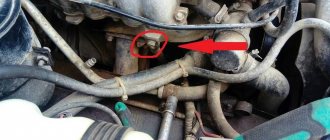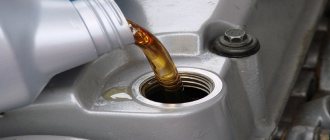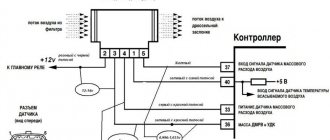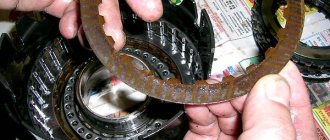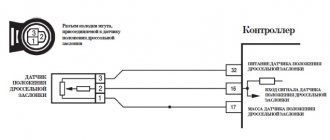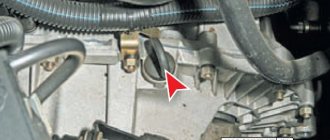- home
- car transmission
- …
As I wrote in a previous article about frequent automatic transmission breakdowns , one of the reasons for incorrect operation may be an incorrect oil level. There is simply more of it (high) or less (low). In both cases, the machine will behave inappropriately. Today I suggest you talk about the low level (we’ll look at it in detail). But when there is more of it, there will be a separate article. As usual there will be a text version + video below...
Very often, a low level is due to breakdowns, for example, the automatic transmission pan has been punctured or some kind of gasket has leaked (although they may not be filled enough). This is because not all automatic transmissions are the same, some models require strong warming up, others almost when cold, this can cause confusion
Why is level so important?
You need to understand that ATF is the fluid in an automatic transmission , it is a working fluid (essentially like a gear), and it must have a certain value. No more, no less.
In extreme cases, malfunctions will appear, which in the future will lead to really serious breakdowns. And repairing a machine, to put it mildly, is not cheap.
Moreover, changing the oil on old automatic transmissions and on new ones is slightly different, if only because the old ones had a dipstick (as well as a filler plug), but the new ones often don’t have one, there is only an inspection window.
Automatic transmission malfunctions
There are completely different signs of automatic transmission malfunction , which can give car owners the necessary information about the nature of the breakdown. For example, if there are problems with the valve body, significant shocks appear when changing gears. Moreover, such shocks are progressive in nature and at the initial stages of the breakdown are barely noticeable, and as the problem progresses, such shocks become more and more noticeable. If there are such problems with an automatic transmission, the car owner needs to contact the appropriate service center as soon as possible, whose specialists will carry out all the necessary repair work.
Automatic transmission malfunctions can also be expressed in the complete impossibility of switching gearbox operating modes or blocking operation in a certain gear. In this case, the car owner needs to transport the broken down car using a tow truck. It is not recommended to drive a car with a broken transmission on your own, as this can lead to serious damage to the drive and the automatic transmission itself.
Never drive a car with a broken transmission
In some cases, a malfunction can be diagnosed using built-in automatic sensors in the automatic transmission. Such sensors indicate insufficient oil pressure in the system, overheating, or problems with gear shifting. At the same time, it must be said that most of these reports of problems with the gearbox are not specific in nature, and it is not possible to make an accurate diagnosis of the breakdown in this case even when using professional computer equipment. The technician will need to inspect the transmission, dismantle it, and only after opening it will he be able to determine the existing breakdown.
Reasons for a drop in automatic transmission oil level
There are many reasons, both external and internal. Let's start with the most difficult thing and specifically about hidden reasons
- Vacuum corrector . Installed on old Mercedes cars, less often FORD and NISSAN. This is a complex structure, but if we just talk about work. It was connected to the engine intake manifold by a pipe; between them there was a membrane, which seemed to sense the vacuum during supply and correct the operation of the automatic transmission, for example, shifting or kickdown.
BUT it happened that the membrane broke, and oil from the automatic transmission got into the intake manifold, and then into the engine. The level in the internal combustion engine was constantly rising, but in the automatic transmission it was falling. Due to the high volume, the engine began to smoke blue smoke , as if there was oil consumption in the engine. BUT if you check the dipstick in the automatic transmission, the level there constantly drops
- Torque converter oil seal . IT seems to lock the oil in the automatic transmission to the “donut”, it should not leak, but sometimes this happens. You can understand this right away; there will be a puddle of red liquid under the car. Moreover, the leak will be in the place where the automatic transmission and engine are mounted.
- The pan or gasket has broken . It often happens when they hit a bump or a stone. Moreover, now on modern automatic transmissions, the pan can be made of plastic; breaking through it can be easy and simple. Also, at the service station, you may install the pan incorrectly after replacing the filter, or install an old gasket, which will also cause a leak.
- A hose or radiator has broken, the clamp has become loose. This is the cooling system of the machine, the reason here is a break in the hoses (perhaps the clamps are loose or not tightened). Sometimes the radiator itself breaks through
- Incorrect replacement at service station . The machines are not the same, sometimes you need to heat the oil and then set the level, but many do not do this, but change it to a cold one. Because of this, the level is not correct, especially in an automatic transmission with a control window.
How to properly check the oil in an automatic transmission?
It is worth remembering that now there are, as it were, two types of machines, these are conventionally old - there is a probe, and conditionally new ones (often this probe simply does not exist) are checked through the control window. For example, a box from KIA - A6LF2, has only an inspection window.
Once again I would like to remind you that on some cars the oil level in the automatic transmission is checked when it is hot, for example at + 70 degrees. On others, they check almost cold, then at + 30. For a correct replacement, you need to refer to the manual of your particular transmission
How to check in the version with a probe
This is the simplest procedure, but again, on modern machines this is often not the case:
- Warming up the automatic transmission, you need to drive a few kilometers
- We place it on a flat surface - this is mandatory (there should be no slope)
- We turn off the internal combustion engine
- We take out the dipstick of the machine, wipe it and put it back in place (this makes for a more accurate level)
- Usually there is a HOT mark on the dipstick (that is, hot), the oil should be within
- If there is more of it, be sure to throw it off, you can pump it out through the dipstick tube with a syringe
- If there is less, just add
How to check if there is no dipstick
This means you have a modern unit, for some reason manufacturers began to abandon the probe:
- Warm up the transmission again
- We drive into a pit or take it up on a lift
- Looking for a control hole
- Do not turn off the engine, take a container for oil (by the way, you need to be careful, it will be hot)
- We unscrew the plug. If the oil poured out, it means there was more of it. If not, then the level is low and needs to be added.
- Take a syringe and add until it flows out of the control window
Just a few drops are enough to pour out of the control hole.
How to avoid problems?
It must be said that the causes of automatic transmission malfunction can be both objective in nature, caused by physical wear, and can be caused by improper operation of this unit. Many car owners neglect the need to regularly change transmission oil, which leads to problems with lubrication and constant overheating of the automatic transmission. As a result, the moving elements of the box quickly fail and require expensive repairs.
READ ALSO Which automatic transmission is the most reliable? How to properly warm up an automatic transmission in winter?
It is also necessary to properly warm up the transmission in the winter, which will eliminate problems with lubrication of the moving elements of the transmission. Low-quality oil damages solenoids, the replacement of which is difficult and expensive. It should also be remembered that automatic transmissions are extremely critical to aggressive driving style. When the engine operates for a long time at maximum speed, the clutches of the automatic transmission can quickly burn out and wear down. That is why it is not recommended to constantly practice an aggressive driving style in a car with an automatic transmission.
The difficulty of repairing automatic transmissions is due to the fact that the failure can only be determined by opening the transmission. To do this, it must be removed from the car, which will allow us to determine the nature of the breakdown. It is not possible for most ordinary motorists to carry out high-quality repairs of an automatic transmission on their own, so it is necessary to contact specialized service centers. Repair work consists of replacing damaged elements, which allows you to restore the functionality of the entire automatic transmission. It should be noted that due to the structural complexity, automatic transmission repair is labor-intensive and high-cost.
How to determine the condition of the automatic transmission yourself - Video
Car service technicians distinguish
3 levels of diagnostics:
1. Quick diagnostics - “Hear”
From the driver’s confused, hasty story, symptoms of a mild malfunction appeared like: “clean the oil from the sensor” or “check the cable that powers the ECU and solenoids” - this is, as a rule, a free diagnosis. But there may be a more serious problem, threatening major repairs and disassembly, but this is a different level...
Self-medication here can be a regular oil change in the automatic transmission or setting the optimal oil level. This happens with four-speed engines that have traveled about 200,000 km.
2. Tactile level - “Touch”
At this level, a routine circuit check may help. This is a matter of a few minutes. A more serious problem can be identified by removing the pan. This is all inexpensive automatic transmission diagnostics.
Also, without dismantling, specialists can make a diagnosis using: a table test, checking the pressure on the line, checking the serviceability of the electrical wiring and reading fault codes.
Self-medication here is the same as in the first case - topping up or completely changing the oil.
3. "Disassemble"
If the automatic emergency mode (permanent 3rd gear) or any other fault listed below is obvious, then disassembly is necessary for a more accurate diagnosis. This is typical for boxes that have traveled more than 200,000 km. This mileage is approaching the time to replace the gas turbine clutch.
Troubleshooting with 100% accuracy will only be achieved by “opening” the automatic transmission.
Symptoms of low ATF fluid levels
There are quite a lot of them, especially noticeable when you arrive in a working car, and after the replacement you drive away and the machine behaves differently than before. Drive 50 - 100 km and if the situation worsens, then you need to go back to the service center and check the oil level
What signs appear:
- Slipping appears. Press the gas pedal, but the car does not move (there is not enough oil pressure to compress the clutch pack)
- Pushes and kicks during work. Again there is not enough working fluid pressure
- Automatic transmission overheating. The smaller the volume, the faster it warms up; there is not enough volume to circulate through the radiator.
- Downshifting. Because with high gears more pressure is needed
- Automatic transmission humming. It vibrates and buzzes a lot
- Doesn't go uphill. On a big hill, it’s as if someone is holding the car from behind.
- Doesn't move. Switch to D – drive, release the pedal, the car should roll a little. If this does not happen, the oil level may be low.
Consequences of low oil level
They can be the most deplorable, but it is impossible to quickly “kill” an automatic transmission; to do this, you need to ignore the problem for hundreds, or even thousands of kilometers.
Once again, if you immediately notice that the transmission is not working correctly, then you need to return to the service station where you changed the oil, most likely the fluid level is low
Consequences - breakdowns:
- Pump wear
- Wear (can quickly burn out) friction discs
- Bearing failure
- Overheating of the automatic transmission, which can affect the condition of the entire box
It is necessary to restore the level to normal as soon as possible. Again, if you have a dipstick, you can add it through its tube; if you don’t have a dipstick, go back to the service station.
I also strongly recommend that everyone take at least half a liter of oil in reserve. So you can add it.
Now let's watch the video version of the material
A low level, just like a high level, does not bring anything good for an automatic transmission; keep it within tolerances and your automatic will run for a very long time. Finally, I would like to note that the oil must be changed (about once every 60,000 km), otherwise, due to high mileage, it will simply become dirty and clog your entire box, the work will not be correct precisely because of the dirt. And that’s all for me, sincerely yours, AUTOBLOGGER
Similar news
- Dual mass flywheel. What is it, how does it work? Breakdowns and r...
- Automatic or manual. What's better? Let's look at the main pros and cons...
- How to check the oil level in a machine?
Engine oil
Much thinner than transmission, divided into three types:
Mineral Semi-synthetic Synthetic
Each type is designed for its own tasks! But with progress, almost 80% of them now use only “semi-synthetics” and “fully synthetics” - this is said by high speeds, the presence of hydraulic compensators, the presence of turbines, etc. These are such complex compositions that you can “enjoy” their properties for a very long time.
It is as liquid as possible - medium viscosity (according to European standards) - 5W - 40 or 5W - 30, less often 0W - 30. It should be applied as simply as possible by an oil pump (through special channels) to the cylinder walls; if it is thick, then proper lubrication is easy will not be executed.
Modern motor oil has really taken a huge STEP forward over the past 20 - 30 years.


